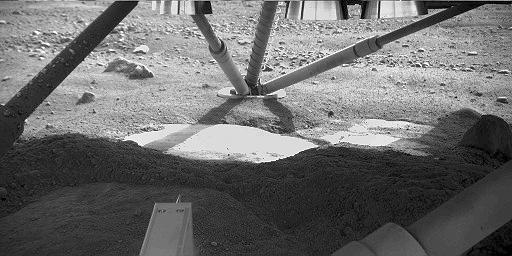
|
Hard Substrate, Possibly Ice, Uncovered Under the Mars Lander
- Click the image above for a larger view
- Full-Res JPEG (512 x 256) (34.2 kB)
- Full-Res TIFF (512 x 256) (131.4 kB)
Caption:
The Robotic Arm Camera on NASA's Phoenix Mars Lander captured this image underneath the lander on the fifth Martian day, or sol, of the mission. Descent thrusters on the bottom of the lander are visible at the top of the image.
This view from the north side of the lander toward the southern leg shows smooth surfaces cleared from overlying soil by the rocket exhaust during landing. One exposed edge of the underlying material was seen in Sol 4 images, but the newer image reveals a greater extent of it. The abundance of excavated smooth and level surfaces adds evidence to a hypothesis that the underlying material is an ice table covered by a thin blanket of soil.
The bright-looking surface material in the center, where the image is partly overexposed, may not be inherently brighter than the foreground material in shadow.
Background Info:
The Phoenix Mission is led by the University of Arizona, Tucson, on behalf of NASA. Project management of the mission is by NASA's Jet Propulsion Laboratory, Pasadena, Calif. Spacecraft development is by Lockheed Martin Space Systems, Denver.
Photojournal Note: As planned, the Phoenix lander, which landed May 25, 2008 23:53 UTC, ended communications in November 2008, about six months after landing, when its solar panels ceased operating in the dark Martian winter.
Cataloging Keywords:
| Name | Value | Additional Values |
|---|---|---|
| Target | Mars | |
| System | ||
| Target Type | Planet | |
| Mission | Phoenix | |
| Instrument Host | Phoenix Lander | |
| Host Type | Lander | |
| Instrument | Robotic Arm Camera (RAC) | |
| Detector | ||
| Extra Keywords | Grayscale, Shadow | |
| Acquisition Date | ||
| Release Date | 2008-05-31 | |
| Date in Caption | ||
| Image Credit | NASA/JPL-Caltech/University of Arizona/Max Planck Institute | |
| Source | photojournal.jpl.nasa.gov/catalog/PIA10741 | |
| Identifier | PIA10741 | |
